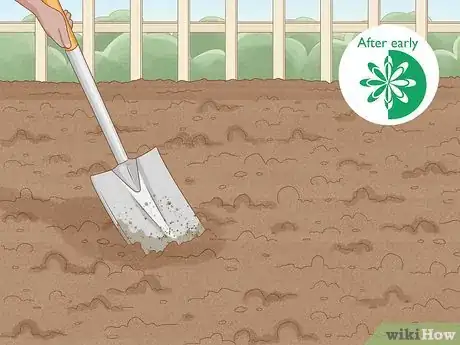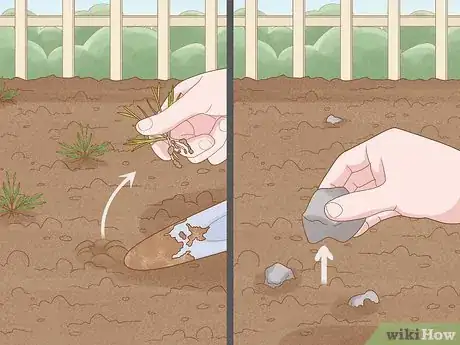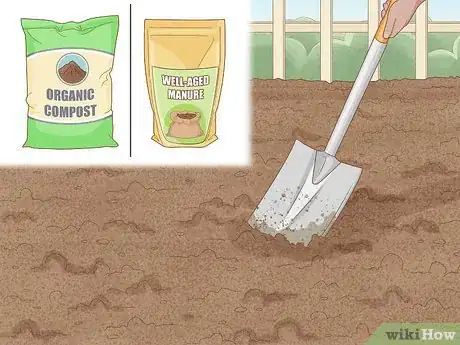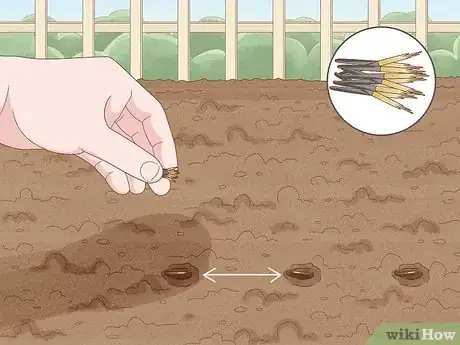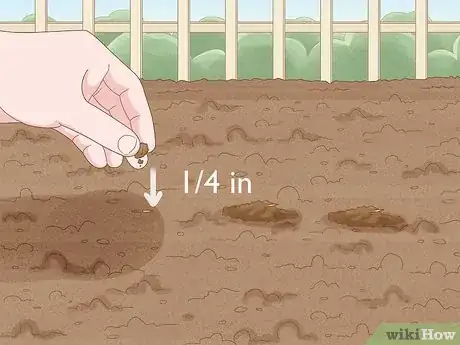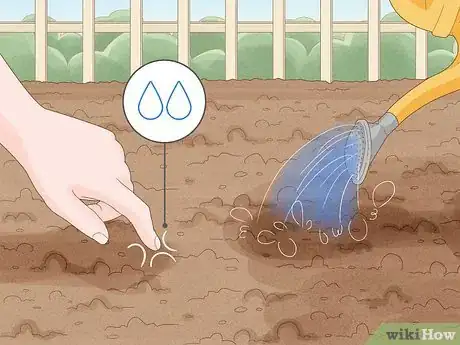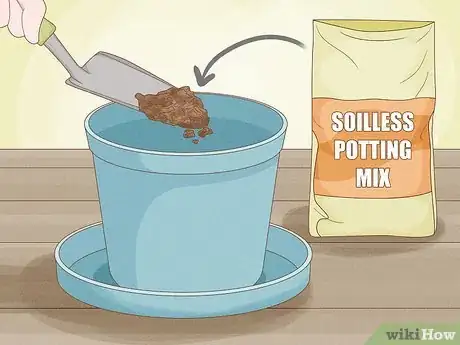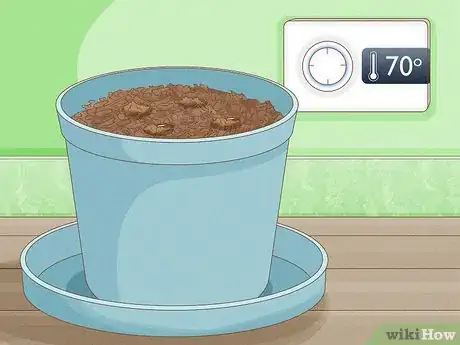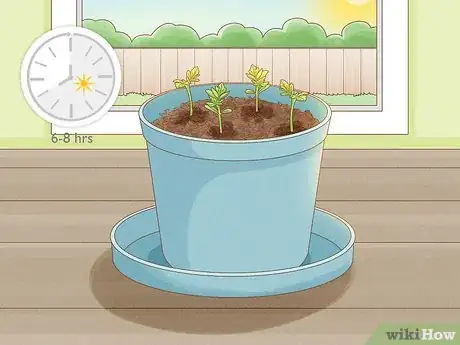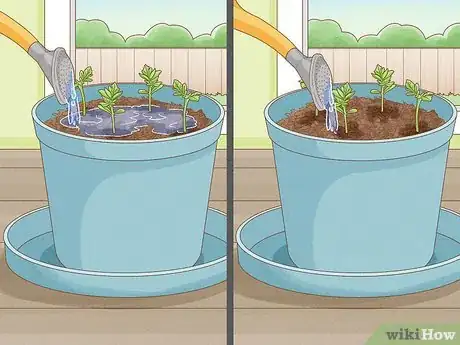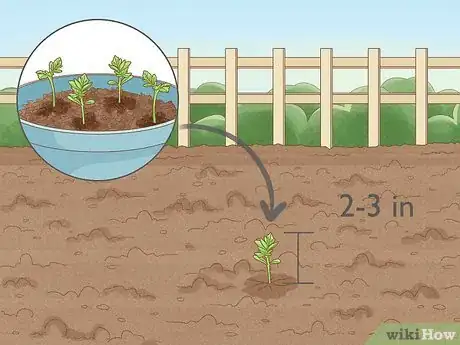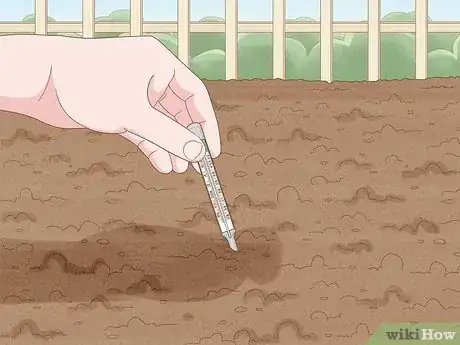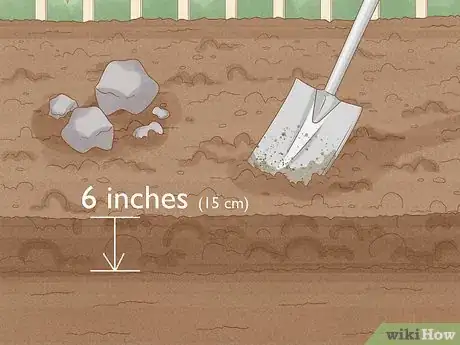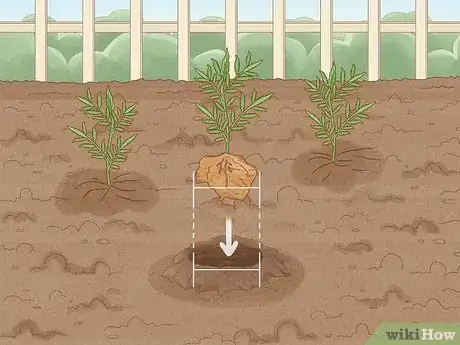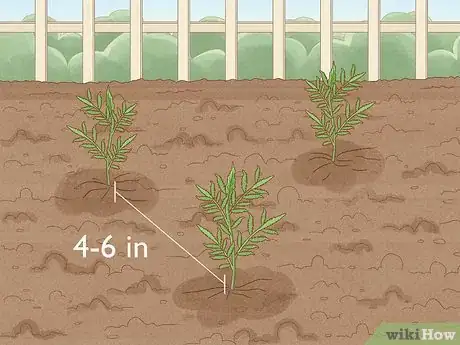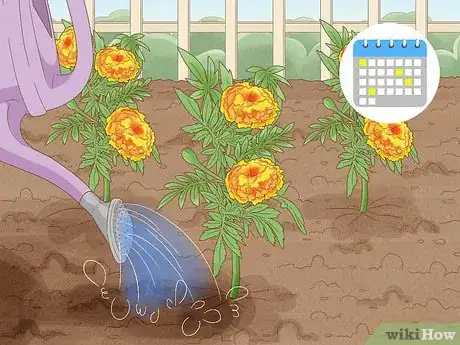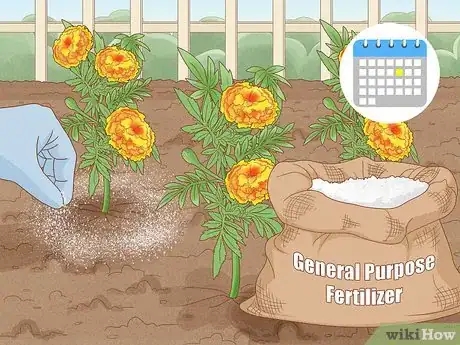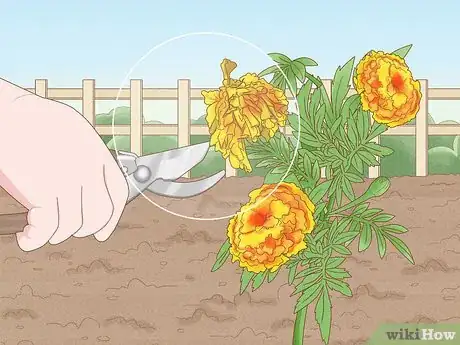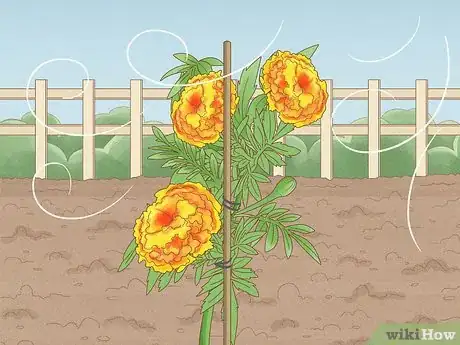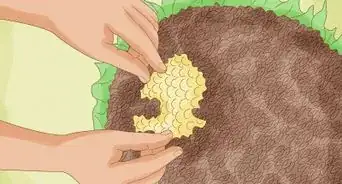This article was co-authored by Katie Gohmann. Katherine Gohmann is a Professional Gardener in Texas. She has been a home gardener and professional gardener since 2008.
There are 16 references cited in this article, which can be found at the bottom of the page.
This article has been viewed 74,854 times.
Marigolds are beautiful, bright flowers that bloom all summer long. They are very easy to maintain and grow best in sunny environments. Marigolds also have been shown to repel insects, rabbits and other animals that can menace your garden, so many people plant them next to plants that attract these pests. They can be grown outside or inside in pots, but they tend to thrive best with a lot of sun exposure. Because they are so easy to grow and maintain, marigolds are a great flower to plant if you do not have very much experience in gardening.
Steps
Planting Marigolds Outside
-
1Wait until spring to start the planting process. You don’t want to plant marigold seeds too early. Wait until early spring is over, and the danger of a spring frost has passed. During mid or late spring, you can begin readying the soil for planting your marigolds.[1]
-
2Make sure the soil of the area isn’t too sandy or dry. Marigolds grow best in loamy, well-drained soil that water can travel through relatively easily. Sandy soil that traps water can stunt the growth of the plant.[2]
- To test whether the garden soil is optimal for planting, dig a 12x12 inch hole that is about 18 inches (46 cm) deep. Fill it with water and let it drain, and then do it again and time how long it takes the water to drain. The water level in well-drained soil goes down about one inch per hour.[3]
Advertisement -
3Weed and clear the area. Before planting marigolds outside, you will want to weed the site you will be planting on. Also make sure to clear away any rocks or debris. This makes the site more hospitable to the marigold plants so that they can grow without interference.[4]
- When you are weeding, grip the weed as close to the soil as you can. You want to try to remove the entire root section of the weed as well as the part above the ground, or else the weed will grow back.
-
4Lay down compost or manure. Before you plant marigolds, mix some organic compost or well-aged manure into the garden soil. This will improve the health of the marigolds by giving them the nutrients they need to thrive.[5]
-
5Plant the seeds on a warm day. You want to make sure that the soil is warm on the day that you are planting the marigold seeds. Cool or cold soil can affect the growing process.[6]
-
6Dig about 8–10 inches (20–25 cm) into the soil. Use a trowel or shovel to dig into the soil 8–10 inches (20.3–25.4 cm). Turn the soil over to break it up and to make it airy. Do this for the entire area in which you will be planting the seeds.[7]
- As you are turning over the soil, make sure to break up any clumps and remove any rocks or pebbles you find.
-
7Sow them in the ground a few inches apart from each other. After you have prepared the soil, drop the marigold seeds in the soil a few inches apart from each other. You don’t want to plant them too close to each other or they could interfere with each other's growth.[8]
-
8Cover the seeds with ¼ inch of soil. Use ¼ inch of soil to cover the marigold seeds. This will ensure that the seeds aren’t too exposed and will be able to grow. Do not use too much soil to cover the seeds; this will make it difficult for the fragile seedlings to poke out of the ground.[9]
-
9Water the seeds regularly. Touch the soil with your fingertips to determine whether or not it needs watering. If it’s dry, gently and carefully sprinkle the seeds with water. Continue keeping the soil moist until the seeds sprout.
Planting Marigolds in Pots
-
1Wait until the start of spring to plant marigolds indoors. If you are growing marigolds indoors, you can start growing six to eight weeks before the last frost date. Because you are growing the flowers indoors, you do not need to worry about the soil being too cold for the plants, which is why you can start growing them earlier.
- If you are growing marigolds in a pot outdoors, you should wait until after the last frost to begin the process.
-
2Use a soilless potting mix for indoor containers. Use a pot filled with soilless/seed-starting potting mix. Soilless potting mix is made up of materials like peat and bark. You can find it at gardening stores or stores like Home Depot and Lowe’s.[10]
- Make sure the pot you are using has drainage holes in the bottom. This will allow water to pass through the pot naturally as it does in the ground.
- You may want to put a board or plate underneath the pot to catch any excess water or soil that comes out of the drainage holes.[11]
-
3Sow the seeds a couple inches apart. Marigolds grown in containers can be planted closer together, but you want to make sure to give the seeds a couple inches of space in between them. Cover the seeds with ¼ inch of soil.[12]
-
4Mix in a slow-acting granular fertilizer. Use about a teaspoon per plant of slow-acting granular fertilizer. This will give your marigolds the nutrients that they need to grow, and are active over a long period of time, about 8-12 weeks.[13]
-
5Keep the temperature around 70 degrees. 70 degrees is a good temperature to aim for in your home. Check your thermostat and make sure that your marigolds are being kept around this temperature. If needed, you can buy a heating pad to put under the pot to keep it at this temperature. Also make sure that you start growing your marigolds away from direct light until germination.[14]
-
6Place the plant in direct light once germination begins. Your marigold plant should start sprouting within 5-7 days. Once the plant has started sprouting, you will want to place it in direct light for at least 6-8 hours everyday. Either place the pot by a window if you live in a sunny climate, or put the pot under a grow lamp.[15]
- If you are growing marigolds in a pot outdoors, keep them in direct sunlight.
-
7Water the marigolds occasionally. Marigolds do not generally require a lot of water, so water every few days. You want to let the soil partially dry out between watering. Too much dampness in the soil can over stimulate marigolds and isn’t good for the plant.[16]
- Water at the roots, and avoid getting the blooms, leaves and stems wet.
Transplanting Marigolds
-
1Try to transplant seedlings, not full plants. Whether you are transplanting a flower from one outdoor spot to another or from a pot to a garden, it’s best for the plants to transplant them when they are seedlings, and only about 2–3 inches (5–8 cm) tall. You can transplant them when they are fully bloomed, but if you can, you should transplant young plants or seedling.
-
2Make sure the soils are consistent temperatures. If the soils are drastically different temperatures, the transplant can be a shock to your plant and it may suffer. Try to make sure that the soil in the pot and the soil you are transplanting to are similar temperatures.[17]
- When you are picking a spot to transplant, find one that receives a lot of sun.
-
3Prepare the soil. Just as you would do when planting seeds, dig about 6 inches (15 cm) into the soil, then turn it over and sift through it. Break up large clumps and remove any stones or rocks.[18]
-
4Transplant the marigolds. Make a hole the size of the marigold root ball in the soil you are transplanting to. Gently remove the marigold plant, keeping some of the planting material around the roots of the plant. Place the plant in the small hole, and pat more soil around the plant.
-
5Space the marigolds 4–6 inches (10.2–15.2 cm) apart. If you are planting more than one marigold, make sure that they are spaced at least 4–6 inches (10.2–15.2 cm) apart. If you are planting a larger marigold variety, space about a foot apart.[19]
Caring for Marigolds
-
1Water marigolds at the base of the plant semi-regularly. The amount you need to water marigold plants depends on your climate, but you will want to try for around once a week. Be sure not to overwater marigolds because it can weaken the plant. Aim to keep the soil moist as opposed to wet.[20]
- Also be sure to water at the base instead of over the top of the plant. This could lead to mildew.[21]
- In times of drought, water marigolds more consistently.
- Especially if you live somewhere that has a hot, dry climate, consider putting some mulch on top of the soil at the base of the plants in order to keep the soil appropriately moist.
-
2Use fertilizer about once a month. Soil that is too rich is not good for marigold plants. However, you should try to pat general purpose fertilizer around the marigold plants about once a month.[22]
-
3Snip off dead blossoms. If you notice that your marigold plant has dead blooms or branches, snip them off with gardening shears. This will help the plant to bloom more freely, and will promote healthy growth for the rest of the plant.[23]
-
4Stake them in windy environments. If the place you live in experiences a lot of wind, stake your plants. Take a thin stake or stick that is slightly shorter than your marigold plant and use plastic ties to loop the plant to the stake. The stake will keep the plant upright and will allow it to survive harsh weather and storms.[24]
Community Q&A
-
QuestionWhat is the period for sowing the seed of marigolds?
 Community AnswerFor indoor plants, sow marigolds six to eight weeks before the last frost date. For outdoor plants, sow them after the last frost in your area. Marigolds usually bloom about 45-50 days after sowing until frost.
Community AnswerFor indoor plants, sow marigolds six to eight weeks before the last frost date. For outdoor plants, sow them after the last frost in your area. Marigolds usually bloom about 45-50 days after sowing until frost. -
QuestionAre marigolds annual or perennial plants?
 Community AnswerMarigolds are annual, so they will die off at the end of the season. They are cheap to buy and easy to start from seed, so don't trouble yourself with trying to save them over the winter!
Community AnswerMarigolds are annual, so they will die off at the end of the season. They are cheap to buy and easy to start from seed, so don't trouble yourself with trying to save them over the winter! -
QuestionWhat do marigold seeds look like?
 Community AnswerMarigold seeds are small and have a long, slender stick-like shape. They are mostly black with flax-colored split ends.
Community AnswerMarigold seeds are small and have a long, slender stick-like shape. They are mostly black with flax-colored split ends.
Warnings
- Make sure not to overwater marigolds. This can damage the plant.⧼thumbs_response⧽
- Do not plant marigolds when there is danger of a frost. This will nip the marigolds in the bud so that they don’t grow.⧼thumbs_response⧽
References
- ↑ http://www.thegardenhelper.com/marigold.html
- ↑ http://www.theflowerexpert.com/content/growingflowers/growingflowers/growing-marigolds
- ↑ http://agebb.missouri.edu/agforest/archives/v10n2/gh14.htm
- ↑ http://gardening.yardener.com/Planting-Marigolds
- ↑ http://www.planetnatural.com/growing-marigolds/
- ↑ http://www.almanac.com/plant/marigolds
- ↑ http://gardening.yardener.com/Planting-Marigolds
- ↑ http://www.burpee.com/gardenadvicecenter/annuals/marigolds/all-about-marigolds/article10240.html
- ↑ http://www.planetnatural.com/growing-marigolds/
- ↑ http://gardening.yardener.com/Planting-Marigolds
- ↑ http://www.todayshomeowner.com/flower-containers-for-beginners/
- ↑ http://timesofindia.indiatimes.com/life-style/home-garden/Six-easy-maintenance-plants-you-can-grow-in-winter/articleshow/50636568.cms
- ↑ http://www.theflowerexpert.com/content/growingflowers/growingflowers/growing-marigolds
- ↑ http://www.gardenershq.com/Calendula-pot-marigold.php
- ↑ http://timesofindia.indiatimes.com/life-style/home-garden/Six-easy-maintenance-plants-you-can-grow-in-winter/articleshow/50636568.cms
- ↑ http://timesofindia.indiatimes.com/life-style/home-garden/Six-easy-maintenance-plants-you-can-grow-in-winter/articleshow/50636568.cms
- ↑ http://www.planetnatural.com/starting-annual-flowers/
- ↑ http://www.burpee.com/gardenadvicecenter/annuals/marigolds/all-about-marigolds/article10240.html
- ↑ http://gardenhobbies.com/flower/marigold.html
- ↑ http://www.canadiangardening.com/plants/annuals/marvelous-marigolds/a/31468/5
- ↑ http://www.gardenershq.com/Calendula-pot-marigold.php
- ↑ http://gardenhobbies.com/flower/marigold.html
- ↑ http://www.mykitchengarden.info/2016/01/how-to-grow-care--marigolds.html
- ↑ http://www.mykitchengarden.info/2016/01/how-to-grow-care--marigolds.html
About This Article
To plant marigolds, start in the spring by finding a spot with well-draining soil, then weeding it and clearing away any rocks or other debris. Next, loosen the soil to a depth of 8-10 inches, and mix in some organic compost or well-aged manure. After that, wait for a relatively warm day, since cold soil can affect the growing process, and drop your seeds into the soil a few inches apart. Then, cover the seeds with ¼ inch of soil and water them regularly to keep the soil moist until the seeds sprout. For tips from our Horticultural reviewer on how to take care of your marigolds after they sprout, scroll down!
